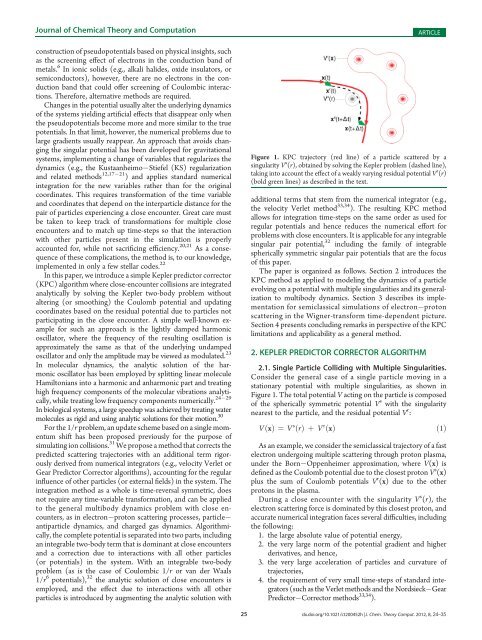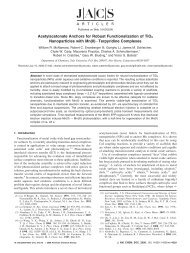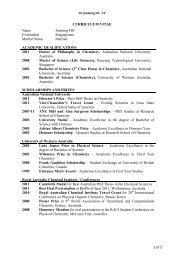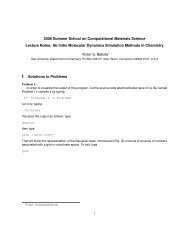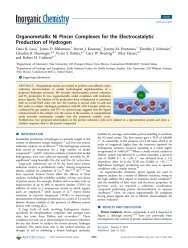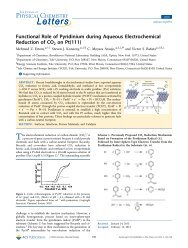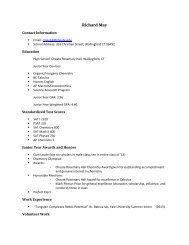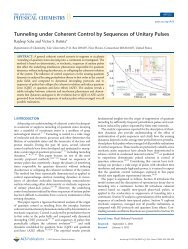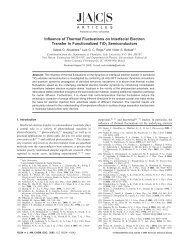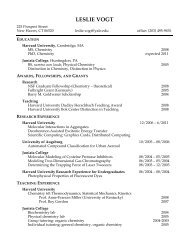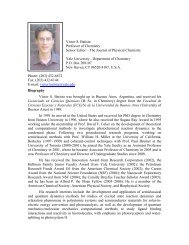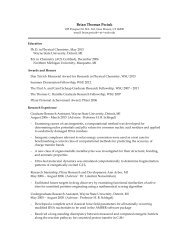Kepler PredictorâCorrector Algorithm - Yale Chemistry - Yale ...
Kepler PredictorâCorrector Algorithm - Yale Chemistry - Yale ...
Kepler PredictorâCorrector Algorithm - Yale Chemistry - Yale ...
Create successful ePaper yourself
Turn your PDF publications into a flip-book with our unique Google optimized e-Paper software.
Journal of Chemical Theory and Computation<br />
construction of pseudopotentials based on physical insights, such<br />
as the screening effect of electrons in the conduction band of<br />
metals. 6 In ionic solids (e.g., alkali halides, oxide insulators, or<br />
semiconductors), however, there are no electrons in the conduction<br />
band that could offer screening of Coulombic interactions.<br />
Therefore, alternative methods are required.<br />
Changes in the potential usually alter the underlying dynamics<br />
of the systems yielding artificial effects that disappear only when<br />
the pseudopotentials become more and more similar to the true<br />
potentials. In that limit, however, the numerical problems due to<br />
large gradients usually reappear. An approach that avoids changing<br />
the singular potential has been developed for gravitational<br />
systems, implementing a change of variables that regularizes the<br />
dynamics (e.g., the Kustaanheimo Stiefel (KS) regularization<br />
and related methods 12,17 21 ) and applies standard numerical<br />
integration for the new variables rather than for the original<br />
coordinates. This requires transformation of the time variable<br />
and coordinates that depend on the interparticle distance for the<br />
pair of particles experiencing a close encounter. Great care must<br />
be taken to keep track of transformations for multiple close<br />
encounters and to match up time-steps so that the interaction<br />
with other particles present in the simulation is properly<br />
accounted for, while not sacrificing efficiency. 20,21 As a consequence<br />
of these complications, the method is, to our knowledge,<br />
implemented in only a few stellar codes. 22<br />
In this paper, we introduce a simple <strong>Kepler</strong> predictor corrector<br />
(KPC) algorithm where close-encounter collisions are integrated<br />
analytically by solving the <strong>Kepler</strong> two-body problem without<br />
altering (or smoothing) the Coulomb potential and updating<br />
coordinates based on the residual potential due to particles not<br />
participating in the close encounter. A simple well-known example<br />
for such an approach is the lightly damped harmonic<br />
oscillator, where the frequency of the resulting oscillation is<br />
approximately the same as that of the underlying undamped<br />
oscillator and only the amplitude may be viewed as modulated. 23<br />
In molecular dynamics, the analytic solution of the harmonic<br />
oscillator has been employed by splitting linear molecule<br />
Hamiltonians into a harmonic and anharmonic part and treating<br />
high frequency components of the molecular vibrations analytically,<br />
while treating low frequency components numerically.<br />
24 29<br />
In biological systems, a large speedup was achieved by treating water<br />
molecules as rigid and using analytic solutions for their motion. 30<br />
For the 1/r problem, an update scheme based on a single momentum<br />
shift has been proposed previously for the purpose of<br />
simulating ion collisions. 31 We propose a method that corrects the<br />
predicted scattering trajectories with an additional term rigorously<br />
derived from numerical integrators (e.g., velocity Verlet or<br />
Gear Predictor Corrector algorithms), accounting for the regular<br />
influence of other particles (or external fields) in the system. The<br />
integration method as a whole is time-reversal symmetric, does<br />
not require any time-variable transformation, and can be applied<br />
to the general multibody dynamics problem with close encounters,<br />
as in electron proton scattering processes, particle<br />
antiparticle dynamics, and charged gas dynamics. <strong>Algorithm</strong>ically,<br />
the complete potential is separated into two parts, including<br />
an integrable two-body term that is dominant at close encounters<br />
and a correction due to interactions with all other particles<br />
(or potentials) in the system. With an integrable two-body<br />
problem (as is the case of Coulombic 1/r or van der Waals<br />
1/r 6 potentials), 32 the analytic solution of close encounters is<br />
employed, and the effect due to interactions with all other<br />
particles is introduced by augmenting the analytic solution with<br />
ARTICLE<br />
Figure 1. KPC trajectory (red line) of a particle scattered by a<br />
singularity V s (r), obtained by solving the <strong>Kepler</strong> problem (dashed line),<br />
taking into account the effect of a weakly varying residual potential V r (r)<br />
(bold green lines) as described in the text.<br />
additional terms that stem from the numerical integrator (e.g.,<br />
the velocity Verlet method 33,34 ). The resulting KPC method<br />
allows for integration time-steps on the same order as used for<br />
regular potentials and hence reduces the numerical effort for<br />
problems with close encounters. It is applicable for any integrable<br />
singular pair potential, 32 including the family of integrable<br />
spherically symmetric singular pair potentials that are the focus<br />
of this paper.<br />
The paper is organized as follows. Section 2 introduces the<br />
KPC method as applied to modeling the dynamics of a particle<br />
evolving on a potential with multiple singularities and its generalization<br />
to multibody dynamics. Section 3 describes its implementation<br />
for semiclassical simulations of electron proton<br />
scattering in the Wigner-transform time-dependent picture.<br />
Section 4 presents concluding remarks in perspective of the KPC<br />
limitations and applicability as a general method.<br />
2. KEPLER PREDICTOR CORRECTOR ALGORITHM<br />
2.1. Single Particle Colliding with Multiple Singularities.<br />
Consider the general case of a single particle moving in a<br />
stationary potential with multiple singularities, as shown in<br />
Figure 1. The total potential V acting on the particle is composed<br />
of the spherically symmetric potential V s with the singularity<br />
nearest to the particle, and the residual potential V r :<br />
VðxÞ ¼V s ðrÞ þV r ðxÞ<br />
As an example, we consider the semiclassical trajectory of a fast<br />
electron undergoing multiple scattering through proton plasma,<br />
under the Born Oppenheimer approximation, where V(x) is<br />
defined as the Coulomb potential due to the closest proton V s (x)<br />
plus the sum of Coulomb potentials V r (x) due to the other<br />
protons in the plasma.<br />
During a close encounter with the singularity V s (r), the<br />
electron scattering force is dominated by this closest proton, and<br />
accurate numerical integration faces several difficulties, including<br />
the following:<br />
1. the large absolute value of potential energy,<br />
2. the very large norm of the potential gradient and higher<br />
derivatives, and hence,<br />
3. the very large acceleration of particles and curvature of<br />
trajectories,<br />
4. the requirement of very small time-steps of standard integrators<br />
(such as the Verlet methods and the Nordsieck Gear<br />
Predictor Corrector methods 33,34 ).<br />
ð1Þ<br />
25 dx.doi.org/10.1021/ct200452h |J. Chem. Theory Comput. 2012, 8, 24–35


